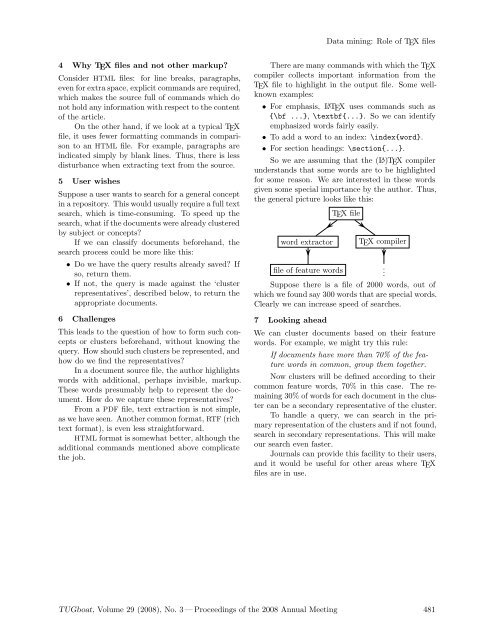The Communications of the TEX Users Group Volume 29 ... - TUG
The Communications of the TEX Users Group Volume 29 ... - TUG
The Communications of the TEX Users Group Volume 29 ... - TUG
You also want an ePaper? Increase the reach of your titles
YUMPU automatically turns print PDFs into web optimized ePapers that Google loves.
4 Why <strong>TEX</strong> files and not o<strong>the</strong>r markup?<br />
Consider HTML files: for line breaks, paragraphs,<br />
even for extra space, explicit commands are required,<br />
which makes <strong>the</strong> source full <strong>of</strong> commands which do<br />
not hold any information with respect to <strong>the</strong> content<br />
<strong>of</strong> <strong>the</strong> article.<br />
On <strong>the</strong> o<strong>the</strong>r hand, if we look at a typical <strong>TEX</strong><br />
file, it uses fewer formatting commands in comparison<br />
to an HTML file. For example, paragraphs are<br />
indicated simply by blank lines. Thus, <strong>the</strong>re is less<br />
disturbance when extracting text from <strong>the</strong> source.<br />
5 User wishes<br />
Suppose a user wants to search for a general concept<br />
in a repository. This would usually require a full text<br />
search, which is time-consuming. To speed up <strong>the</strong><br />
search, what if <strong>the</strong> documents were already clustered<br />
by subject or concepts?<br />
If we can classify documents beforehand, <strong>the</strong><br />
search process could be more like this:<br />
• Do we have <strong>the</strong> query results already saved? If<br />
so, return <strong>the</strong>m.<br />
• If not, <strong>the</strong> query is made against <strong>the</strong> ‘cluster<br />
representatives’, described below, to return <strong>the</strong><br />
appropriate documents.<br />
6 Challenges<br />
This leads to <strong>the</strong> question <strong>of</strong> how to form such concepts<br />
or clusters beforehand, without knowing <strong>the</strong><br />
query. How should such clusters be represented, and<br />
how do we find <strong>the</strong> representatives?<br />
In a document source file, <strong>the</strong> author highlights<br />
words with additional, perhaps invisible, markup.<br />
<strong>The</strong>se words presumably help to represent <strong>the</strong> document.<br />
How do we capture <strong>the</strong>se representatives?<br />
From a PDF file, text extraction is not simple,<br />
as we have seen. Ano<strong>the</strong>r common format, RTF (rich<br />
text format), is even less straightforward.<br />
HTML format is somewhat better, although <strong>the</strong><br />
additional commands mentioned above complicate<br />
<strong>the</strong> job.<br />
Data mining: Role <strong>of</strong> <strong>TEX</strong> files<br />
<strong>The</strong>re are many commands with which <strong>the</strong> <strong>TEX</strong><br />
compiler collects important information from <strong>the</strong><br />
<strong>TEX</strong> file to highlight in <strong>the</strong> output file. Some wellknown<br />
examples:<br />
• For emphasis, L A<strong>TEX</strong> uses commands such as<br />
{\bf ...}, \textbf{...}. So we can identify<br />
emphasized words fairly easily.<br />
• To add a word to an index: \index{word}.<br />
• For section headings: \section{...}.<br />
So we are assuming that <strong>the</strong> (L A)<strong>TEX</strong> compiler<br />
understands that some words are to be highlighted<br />
for some reason. We are interested in <strong>the</strong>se words<br />
given some special importance by <strong>the</strong> author. Thus,<br />
<strong>the</strong> general picture looks like this:<br />
word extractor<br />
<strong>TEX</strong> file<br />
<strong>TEX</strong> compiler<br />
file <strong>of</strong> feature words .<br />
.<br />
Suppose <strong>the</strong>re is a file <strong>of</strong> 2000 words, out <strong>of</strong><br />
which we found say 300 words that are special words.<br />
Clearly we can increase speed <strong>of</strong> searches.<br />
7 Looking ahead<br />
We can cluster documents based on <strong>the</strong>ir feature<br />
words. For example, we might try this rule:<br />
If documents have more than 70% <strong>of</strong> <strong>the</strong> feature<br />
words in common, group <strong>the</strong>m toge<strong>the</strong>r.<br />
Now clusters will be defined according to <strong>the</strong>ir<br />
common feature words, 70% in this case. <strong>The</strong> remaining<br />
30% <strong>of</strong> words for each document in <strong>the</strong> cluster<br />
can be a secondary representative <strong>of</strong> <strong>the</strong> cluster.<br />
To handle a query, we can search in <strong>the</strong> primary<br />
representation <strong>of</strong> <strong>the</strong> clusters and if not found,<br />
search in secondary representations. This will make<br />
our search even faster.<br />
Journals can provide this facility to <strong>the</strong>ir users,<br />
and it would be useful for o<strong>the</strong>r areas where <strong>TEX</strong><br />
files are in use.<br />
<strong>TUG</strong>boat, <strong>Volume</strong> <strong>29</strong> (2008), No. 3 — Proceedings <strong>of</strong> <strong>the</strong> 2008 Annual Meeting 481

















